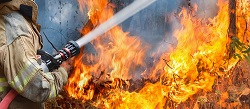The threat of fire is a year-round risk in Australia. However, for anyone living on – or managing – a small farm, a long hot summer and the onset of the declared fire season is the time to be proactive and to prepare for bushfires.
Having a fire management plan in place to protect your property, machinery, livestock and especially your loved ones is the best defence against bushfires and grassfires.

Bushfires and grassfires can spread quickly and primarily do so through direct flame contact, heat transfer and embers.
Fire behaviour is influenced by three main factors: fuel, weather and topography. Consideration of these factors is important when considering bushfire management. How hot a fire burns and how quickly it spreads depends on the size, quantity, type, arrangement and moisture content of the fuel being burnt. It is a legal requirement to minimise fuel loads on-farm to defend against fire fronts.
Recent Australian research indicates that around 47% of bushfires are started accidentally by human activity, including sparks from machinery and equipment, escaped burn-offs or cigarettes.
Things to include in a bushfire management plan
Simple measures that can be incorporated into a fire management plan, and can be employed year-round to prepare and protect your small farm from fire, include:
- Keep grass short by mowing, grazing or slashing. A good season gives rise to a bulk of feed that, if not managed, can become a cured, dry mass of fuel for a fire.
- Maintain machinery and avoid using tractors, chainsaws, augers, welders and other electrical or petrol equipment on hot and windy days. If you do need to use machinery under such circumstances, ensure it is in good working order and carry fire suppression equipment such as a working water fire extinguisher or dry powder fire extinguisher, or a knapsack spray pump filled with water.
- Know where you can move your animals to safety, and ensure access/exit points are clear of obstruction and can be operated with ease.
- Keep firefighting units in good order, filled with water, and located in an easily accessible place.
- Maintain a defendable space (at least 20 metres but up to 85 metres where possible) around homes and valuable assets: move any woodpiles or other flammable material away from buildings.
- Store petrol and fuel safely away from the house, preferably in a shed.
- Trim branches away from power lines.
Firebreaks
Firebreaks are cleared paths and borders (mown, intensively grazed, slashed or ploughed) that can help slow or stop the spread of fires, particularly from reaching valuable assets such as crops, livestock or buildings.
Effective firebreaks that are a minimum of 15 metres wide can prevent fire escaping onto neighbouring land and reduce the likelihood of fires entering your small farm.
Firebreaks are the responsibility of all landowners, and working together with neighbours is a great way to keep on top of the work load when planning and preparing firebreaks.
Preparing and updating your bushfire management plan
Aim to have a written fire plan that takes into account everyone on your farm, and revisit the plan annually by checking each element and discussing the plan with family, employees and neighbours. The safest option is always to leave early.
What to do if there is a grass fire
If you see an unattended grass fire, or if your life is in danger, call Triple Zero (000). The next important step is to follow your fire plan. If you become trapped, always keep the burnt ground in mind as a safety refuge point or move to a ploughed or well-grazed paddock.
If you stay and risk defending your property, always protect yourself by covering up all exposed skin with protective clothing such as:
- Long-sleeved shirt and pants made from a natural fibre such as cotton
- Sturdy leather boots and woollen socks
- Leather gloves
- A wide-brimmed hat
- A face mask or towel to cover your mouth and nose
- Eye protection such as goggles.
Total Fire Bans
Total Fire Bans are declared on all land (both public and private) on days when the fire danger is extremely high. During a Total Fire Ban, there are strict and legally enforceable rules regarding the lighting of fires, and all fire permits are immediately suspended. The ban applies to incinerators and barbecues which burn solid fuel, such as wood and charcoal. However, the use of a gas or electric barbecue is permitted under limited circumstances.
Each state has its own fire danger ratings system, so ensure you are familiar with the relevant terminology and advice before fire ban season arrives. Fire danger refers to how difficult a fire will be to control given certain weather and fuel conditions.
Fire danger information is available from the Australian Bureau of Meteorology and from the relevant fire authority in each state and territory.
For more information regarding bushfire preparation and management visit Essential Bushfire Safety Tips
About the author
| The author Liz Rymill is a first-generation farmer running a prime lamb operation in South Australia's South East, with her husband and young family.She is interested in combining best practice land management, animal welfare and a profitable business model. Liz has been researching and writing about Australian agriculture for the last ten years through her Sheepdog Ink consultancy. |



